Lagrange Multiplier-Based Optimization for Hybrid Energy Management System with Renewable Energy Sources and Electric Vehicles
Abstract
:1. Introduction
- First, the proposed HEMS employs the built-in batteries of EVs as mobile ESSs, thereby significantly reducing the investment costs associated with stationary ESSs. Moreover, the HEMS incorporates electricity trading to capitalize on the fluctuating electricity prices based on the time frame, thus leading to a decrease in energy utilization costs. These functions help boost the economic benefits of users.
- Second, the designed HEMS considers the power exchange limits of the electrical grid, load variations and SOC of batteries to appropriately curtail the generating capacity in the event of excess renewable energy in the system for ensuring energy balance and stability. This approach is particularly relevant in regions with surplus solar and wind power, such as the central coast provinces of Vietnam as considered in test cases of this paper. By implementing this HEMS, the energy generated by the national power grid and solar/wind power sources can be efficiently utilized and stored, resulting in a sustainable and cost-effective energy system.
- Finally, the proposed optimization algorithm used in the HEMS is based on Lagrange multiplier theory and operates on the principle of prioritization, which helps to attain good performance, reduces the computational burden, and is relatively simple to implement.
2. Microgrid Models
3. Optimization Method
- Form the Lagrangian function :where x represents the variables of the objective function, λ and represent the Lagrange multipliers, represents the equality constraints, and represents the equality constraints.
- Solve the following system of equations to obtain ()
- Calculate the value of the objective function f(x) based on the optimal solution ():
3.1. Mathematical Model of EMS
- Predicted load levels for every hour of the upcoming day
- Predicted wind and solar energy generation levels for every hour of the upcoming day
- Characteristics, power limits, and cost functions for each system component
- Starting charge level of the energy storage system
- Starting charge level and departure schedule of electric vehicles
- Electricity pricing information
- F: cost function of the system;
- Fde(): cost function of the diesel engine;
- Fess(): cost function of the stationary battery;
- Fev(): cost function of the EV’s built-in battery;
- Fg(): cost function of the national grid;
- Pde(t): power of the diesel engine at point time t;
- Pg(t): power of the national grid at point time t;
- SOC(t): state of charge of the stationary battery at point time t;
- evSOC(t): state of charge of the EV’s built-in battery at point time t.
- : minimum power of the diesel engine;
- : maximum power of the diesel engine.
- Pde (t): power of the diesel engine at point time t;
- Pg (t): power of the national grid at point time t;
- Pess (t): power of the stationary battery at point time t;
- Ploads (t): power of the loads at point time t;
- Pev (t): power of the EV’s built-in battery at point time t;
- PWt (t): power of the wind turbine at point time t;
- Ppv (t): power of the photovoltaic array at point time t.
- : minimum power of the stationary battery;
- : maximum power of the stationary battery.
- : minimum power of the EV’s built-in battery;
- : maximum power of the EV’s built-in battery.
- : minimum capacity of the stationary battery;
- : maximum capacity of the stationary battery;
- : minimum capacity of the EV’s built-in battery;
- : maximum capacity of the EV’s built-in battery;
- EV(t): Operating status of EV (EV(t) = 1: EV is at home; EV(t) = 0: EV is not at home);
- : weighting factor assigns the significance of the battery life [12].
3.2. Applying Optimize Technique
- min1 = (minimum capacity of the EV’s built-in battery);
- max1 = (maximum capacity of the EV’s built-in battery);
- min2 = (minimum capacity of the stationary battery);
- max2 = (maximum capacity of the stationary battery);
- min3 = (minimum power of the diesel engine);
- max3 = (maximum power of the diesel engine).
| Algorithm 1. Cost function minimization |
| 1. ) |
| 2. Determine the optimal value: |
| )) |
| 3. if) |
| 4. using (9) |
| 5. |
| 6. if ) |
| 7. using (7) |
| 8. |
| 9. end |
| 10. if ) |
| 11. at limit |
| 12. end |
| 13. using (4) |
| 14. if) |
| 15. to limit |
| 16. Reduce the power of stationary battery and EV’s battery, priority reduce the power of EV then the stationary battery |
| 17. end |
| 18. end |
4. Simulation Results
4.1. Isolated Operation Mode
4.2. Grid-Connected Operation Mode
5. Conclusions
6. Data Collection for Study Cases
Author Contributions
Funding
Data Availability Statement
Conflicts of Interest
Nomenclature
| a, b, c | Coefficients in cost function of diesel engine that are proportional to diesel price |
| evSOC | State of charge of EV’s built-in battery |
| Minimum capacity of EV’s built-in battery | |
| Maximum capacity of EV’s built-in battery | |
| EV(t) | Operating status of EV |
| F | Cost function of designed microgrid system |
| Fde | Cost function of diesel engine |
| Fess | Cost function of stationary battery |
| Fev | Cost function of EV’s built-in battery |
| Fg | Cost function of national power grid |
| k1, k2, k3 | Coefficients in cost function of battery that are related to rated depth of discharge of battery |
| Weighting factor in cost function of battery that assigns significance of battery life | |
| Pde | Power of diesel engine |
| Minimum power of diesel engine | |
| Maximum power of diesel engine | |
| Pev | Power of EV’s built-in battery |
| Minimum power of EV’s built-in battery | |
| Maximum power of EV’s built-in battery | |
| Pess | Power of stationary battery |
| Minimum power of stationary battery | |
| Maximum power of stationary battery | |
| Pg | Power of national power grid |
| Ploads | Power of loads |
| Ppv | Power of photovoltaic array |
| PWt | Power of wind turbine |
| SOC | State of charge of stationary battery |
| Minimum capacity of stationary battery | |
| Maximum capacity of stationary battery |
Appendix A
References
- Lasseter, R.H.; Paigi, P. Microgrid: A conceptual solution. In Proceedings of the IEEE 35th Annual Power Electronics Specialists Conference, Aachen, Germany, 20–25 June 2004; pp. 4285–4290. [Google Scholar]
- Bevrani, H.; Ghosh, A.; Ledwich, G. Renewable energy sources and frequency regulation: Survey and new perspectives. IET Renew. Power Gener. 2010, 4, 438–457. [Google Scholar] [CrossRef]
- Iqbal, S.; Xin, A.; Jan, M.U.; Salman, S.; Zaki, A.U.M.; Rehman, H.U.; Shinwari, M.F.; Abdelbaky, M.A. V2G Strategy for Primary Frequency Control of an Industrial Microgrid Considering the Charging Station Operator. Electronics 2020, 9, 549. [Google Scholar] [CrossRef]
- Leon, J.I.; Vazquez, S.; Franquelo, L.G. Multilevel Converters: Control and Modulation Techniques for Their Operation and Industrial Applications. Proc. IEEE 2017, 105, 2066–2081. [Google Scholar] [CrossRef]
- de Souza Ribeiro, L.A.; Saavedra, O.R.; de Lima, S.L.; de Matos, J.G. Isolated micro-grids with renewable hybrid generation: The case of Lençóis island. IEEE Trans. Sustain. Energy 2011, 2, 1–11. [Google Scholar] [CrossRef]
- Pannala, S.; Padhy, N.P.; Agarwal, P. Effective power management scheme for PV-Battery-DG integrated standalone DC microgrid. IET Electr. Power Appl. 2020, 14, 2322–2330. [Google Scholar] [CrossRef]
- Bevrani, H.; Feizi, M.R.; Ataee, S. Robust frequency control in an islanded microgrid: H1 and µ-Synthesis approaches. IEEE Trans. Smart Grid 2015, 7, 706–717. [Google Scholar] [CrossRef]
- Frasetyo, M.B.; Wijaya, F.D.; Ali, H.R. Islanded wind farm microgrid stability control using synchronverter algorithm. IEEJ J. Ind. Appl. 2023, 12, 603–612. [Google Scholar] [CrossRef]
- Vazquez, S.; Lukic, S.; Galvan, E.; Franquelo, L.G.; Carrasco, J.M.; Leon, J.I. Recent advances on energy storage systems. In Proceedings of the 37th Annual Conference of the IEEE Industrial Electronics Society, Melbourne, Australia, 7–10 November 2011; pp. 4636–4640. [Google Scholar]
- Xu, D.; Liu, J.; Yan, X.-G.; Yan, W. A novel adaptive neural network constrained control for a multi-area interconnected power system with hybrid energy storage. IEEE Trans. Ind. Electron. 2018, 65, 6625–6634. [Google Scholar] [CrossRef]
- Kempton, W.; Letendre, S.E. Electric vehicles as a new power source for electric utilities. Transp. Res. D Transp. Environ. 1997, 2, 157–175. [Google Scholar] [CrossRef]
- Zhao, Z. Optimal Energy Management for Microgrids. Ph.D. Thesis, Clemson University, Greenville, SC, USA, 2012. [Google Scholar]
- Thao, N.G.M.; Uchida, K.; Kofuji, K.; Jintsugawa, T.; Nakazawa, C. An automatic-tuning scheme based on fuzzy logic for active power filter in wind farms. IEEE Trans. Control Syst. Technol. 2019, 27, 1694–1702. [Google Scholar] [CrossRef]
- Wang, S.; Ge, L.; Wang, K.; Cai, S.; Mihet-Popa, L. Energy management and economic operation optimization of microgrid under uncertainty. In Energy Management of Distributed Generation Systems; IntechOpen: London, UK, 2016; p. 249. [Google Scholar]
- Elsied, M.; Oukaour, A.; Gualous, H.; Hassan, R. Energy management and optimization in microgrid system based on green energy. Energy 2015, 84, 139–151. [Google Scholar] [CrossRef]
- Tian, P.; Xiao, X.; Wang, K.; Ding, R. A hierarchical energy management system based on hierarchical optimization for microgrid community economic operation. IEEE Trans. Smart Grid 2016, 7, 2230–2241. [Google Scholar] [CrossRef]
- Indragandhi, V.; Logesh, R.; Subramaniyaswamy, V.; Vijayakumar, V.; Siarry, P.; Uden, L. Multi-objective optimization and energy management in renewable based AC/DC microgrid. Comput. Electr. Eng. 2018, 70, 179–198. [Google Scholar]
- Marzband, M.; Yousefnejad, E.; Sumper, A.; Domínguez-García, J.L. Real time experimental implementation of optimum energy management system in standalone microgrid by using multi-layer ant colony optimization. Int. J. Electr. Power Energy Syst. 2016, 75, 265–274. [Google Scholar] [CrossRef]
- Dulău, L.I.; Bică, D. Optimization of generation cost in a microgrid. Procedia Manuf. 2018, 22, 703–708. [Google Scholar] [CrossRef]
- Porsinger, T.; Janik, P.; Leonowicz, Z.; Gono, R. Modelling and Optimization in Microgrids. Energies 2017, 10, 523. [Google Scholar] [CrossRef]
- Zhang, W.; Maleki, A.; Rosen, M.A.; Liu, J. Optimization with a simulated annealing algorithm of a hybrid system for renewable energy including battery and hydrogen storage. Energy 2018, 163, 191–207. [Google Scholar] [CrossRef]
- Yamaguchi, T.; Matsumoto, T. Autonomous control for cooperative operation between energy storage systems. IEEJ J. Ind. Appl. 2023, 12, 643–652. [Google Scholar] [CrossRef]
- Eydi, M.; Alishahi, M.; Zarif, M. A novel output power determination and power distribution of hybrid energy storage system for wind turbine power smoothing. IET Electr. Power Appl. 2022, 16, 1559–1575. [Google Scholar] [CrossRef]
- Mansouri, S.; Zishan, F.; Montoya, O.D.; Azimizadeh, M.; Giral-Ramírez, D.A. Using an intelligent method for microgrid generation and operation planning while considering load uncertainty. Results Eng. 2023, 17, 100978. [Google Scholar] [CrossRef]
- Shirole, A.; Wagh, M.; Kulkarni, V.; Patil, P. Short-term energy scenario of district energy system using optimised renewable energy mix with and without energy storage. Results Eng. 2023, 18, 101017. [Google Scholar] [CrossRef]
- Twaisan, K.; Barışçı, N. Integrated Distributed Energy Resources (DER) and Microgrids: Modeling and Optimization of DERs. Electronics 2022, 11, 2816. [Google Scholar] [CrossRef]
- Dong, H.; Fang, Z.; Ibrahim, A.-W.; Cai, J. Optimized Operation of Integrated Energy Microgrid with Energy Storage Based on Short-Term Load Forecasting. Electronics 2021, 11, 22. [Google Scholar] [CrossRef]
- Lv, J.; Wang, X.; Wang, G.; Song, Y. Research on Control Strategy of Isolated DC Microgrid Based on SOC of Energy Storage System. Electronics 2021, 10, 834. [Google Scholar] [CrossRef]
- Olivares, D.E.; Canizares, C.A.; Kazerani, M. A centralized optimal energy management system for microgrids. In Proceedings of the 2011 IEEE Power and Energy Society General Meeting, Detroit, MI, USA, 24–28 July 2011; pp. 1–6. [Google Scholar]
- Hazem Mohammed, O.; Amirat, Y.; Benbouzid, M. Economical Evaluation and Optimal Energy Management of a Stand-Alone Hybrid Energy System Handling in Genetic Algorithm Strategies. Electronics 2018, 7, 233. [Google Scholar] [CrossRef]
- Baziar, A.; Kavousi-Fard, A. Considering uncertainty in the optimal energy management of renewable micro-grids including storage devices. Renew. Energy 2013, 59, 158–166. [Google Scholar] [CrossRef]
- Hosseinzadeh, M.; Salmasi, F.R. Robust Optimal Power Management System for a Hybrid AC/DC Micro-Grid. IEEE Trans. Sustain. Energy 2015, 6, 675–687. [Google Scholar] [CrossRef]
- Thirunavukkarasu, G.S.; Seyedmahmoudian, M.; Jamei, E.; Horan, B.; Mekhilef, S.; Stojcevski, A. Role of optimization techniques in microgrid energy management systems—A review. Energy Strategy Rev. 2022, 43, 100899. [Google Scholar] [CrossRef]
- Shezan, S.A.; Kamwa, I.; Ishraque, F.; Muyeen, S.M.; Hasan, K.N.; Saidur, R.; Rizvi, S.M.; Shafiullah; Al-Sulaiman, F.A. Evaluation of Different Optimization Techniques and Control Strategies of Hybrid Microgrid: A Review. Energies 2023, 16, 1792. [Google Scholar] [CrossRef]
- Lipu, M.H.; Ansari, S.; Miah, S.; Hasan, K.; Meraj, S.T.; Faisal, M.; Jamal, T.; Ali, S.H.; Hussain, A.; Muttaqi, K.M.; et al. A review of controllers and optimizations based scheduling operation for battery energy storage system towards decarbonization in microgrid: Challenges and future directions. J. Clean. Prod. 2022, 360, 132188. [Google Scholar] [CrossRef]
- Shafiullah, M.; Refat, A.M.; Haque, M.E.; Chowdhury, D.M.H.; Hossain, M.S.; Alharbi, A.G.; Alam, M.S.; Ali, A.; Hossain, S. Review of recent developments in microgrid energy management strategies. Sustainability 2022, 14, 14794. [Google Scholar] [CrossRef]
- Tostado-Véliz, M.; Kamel, S.; Hasanien, H.M.; Turky, R.A.; Jurado, F. Uncertainty-aware day-ahead scheduling of microgrids considering response fatigue: An IGDT approach. Appl. Energy 2022, 310, 118611. [Google Scholar] [CrossRef]
- Kamal, F.; Chowdhury, B. Model predictive control and optimization of networked microgrids. Int. J. Electr. Power Energy Syst. 2022, 138, 107804. [Google Scholar] [CrossRef]
- Alvarez, J.A.M.; Zurbriggen, I.G.; Paz, F.; Ordonez, M. Microgrids Multiobjective Design Optimization for Critical Loads. IEEE Trans. Smart Grid 2022, 14, 17–28. [Google Scholar] [CrossRef]
- Cavus, M.; Allahham, A.; Adhikari, K.; Zangiabadi, M.; Giaouris, D. Energy Management of Grid-Connected Microgrids Using an Optimal Systems Approach. IEEE Access 2023, 11, 9907–9919. [Google Scholar] [CrossRef]
- Ali, M.; Abdulgalil, M.A.; Habiballah, I.; Khalid, M. Optimal Scheduling of Isolated Microgrids with Hybrid Renewables and Energy Storage Systems Considering Demand Response. IEEE Access 2023, 11, 80266–80273. [Google Scholar] [CrossRef]
- Tran, H.G.; Thao, N.G.M. Ton-That. Energy management and optimization method based on Lagrange multiplier for microgrid with considerations of electricity price and vehicle. In Proceedings of the 2021 IEEE 10th Global Conference on Consumer Electronics, Kyoto, Japan, 12–15 October 2021; pp. 951–952. [Google Scholar]
- Drouilhet, S.; Johnson, B.; Drouilhet, S.; Johnson, B. A battery life prediction method for hybrid power applications. In Proceedings of the 35th Aerospace Sciences Meeting and Exhibit, Reno, NV, USA, 6–9 January 1997; p. 948. [Google Scholar]
- Thao, N.G.M.; Uchida, K. An improved interval fuzzy modeling: Applications to estimate photovoltaic/wind/battery power in renewable energy systems. Energies 2018, 11, 482. [Google Scholar] [CrossRef]
- Mukhatov, A.; Thao, N.G.M.; Do, T.D. Linear quadratic regulator and fuzzy control for grid-connected photovoltaic systems. Energies 2022, 15, 1286. [Google Scholar] [CrossRef]
- Retail Electricity Price in Vietnam. Available online: https://www.evn.com.vn/c3/evn-va-khach-hang/Bieu-gia-ban-le-dien-9-79.aspx (accessed on 29 October 2023).
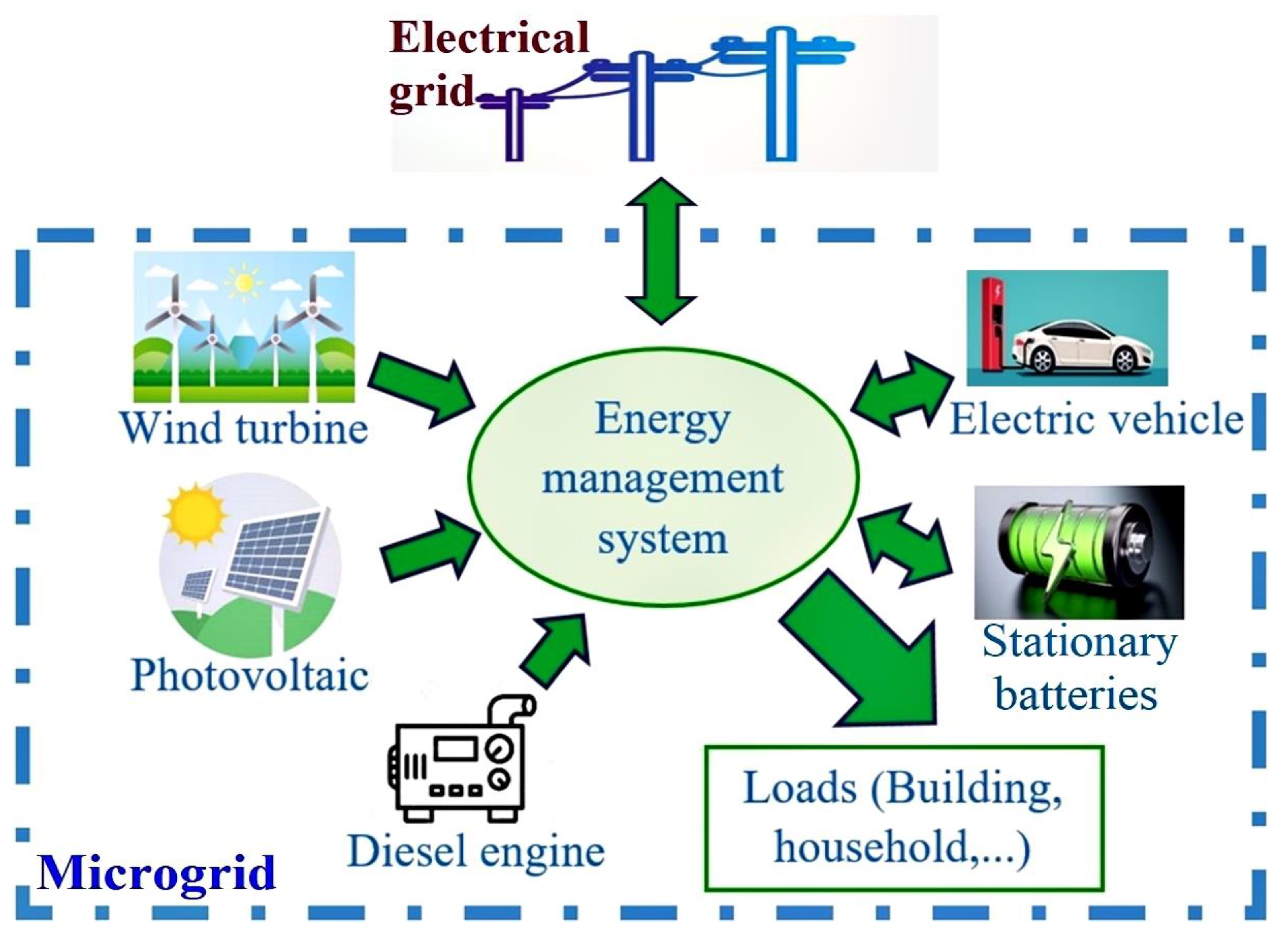

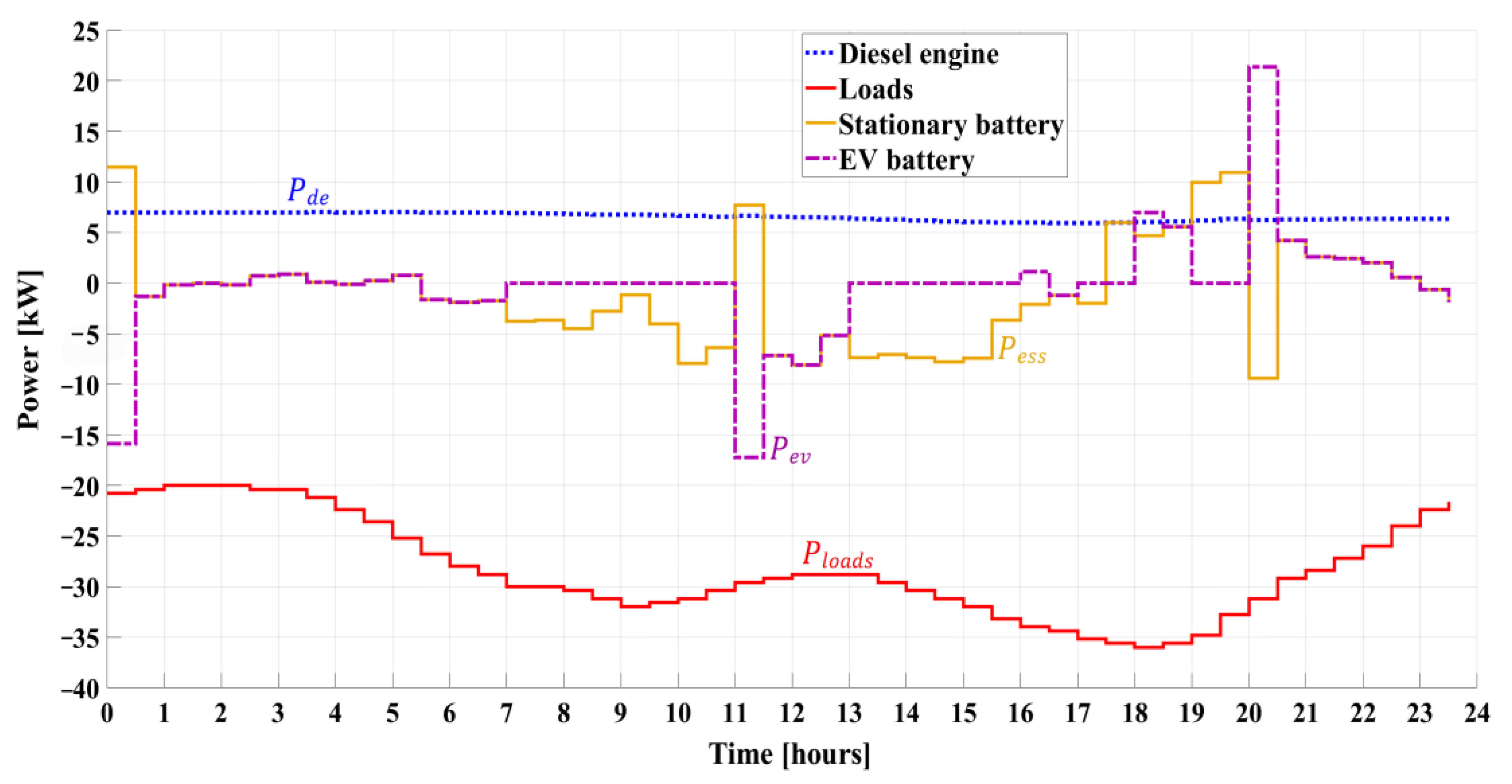
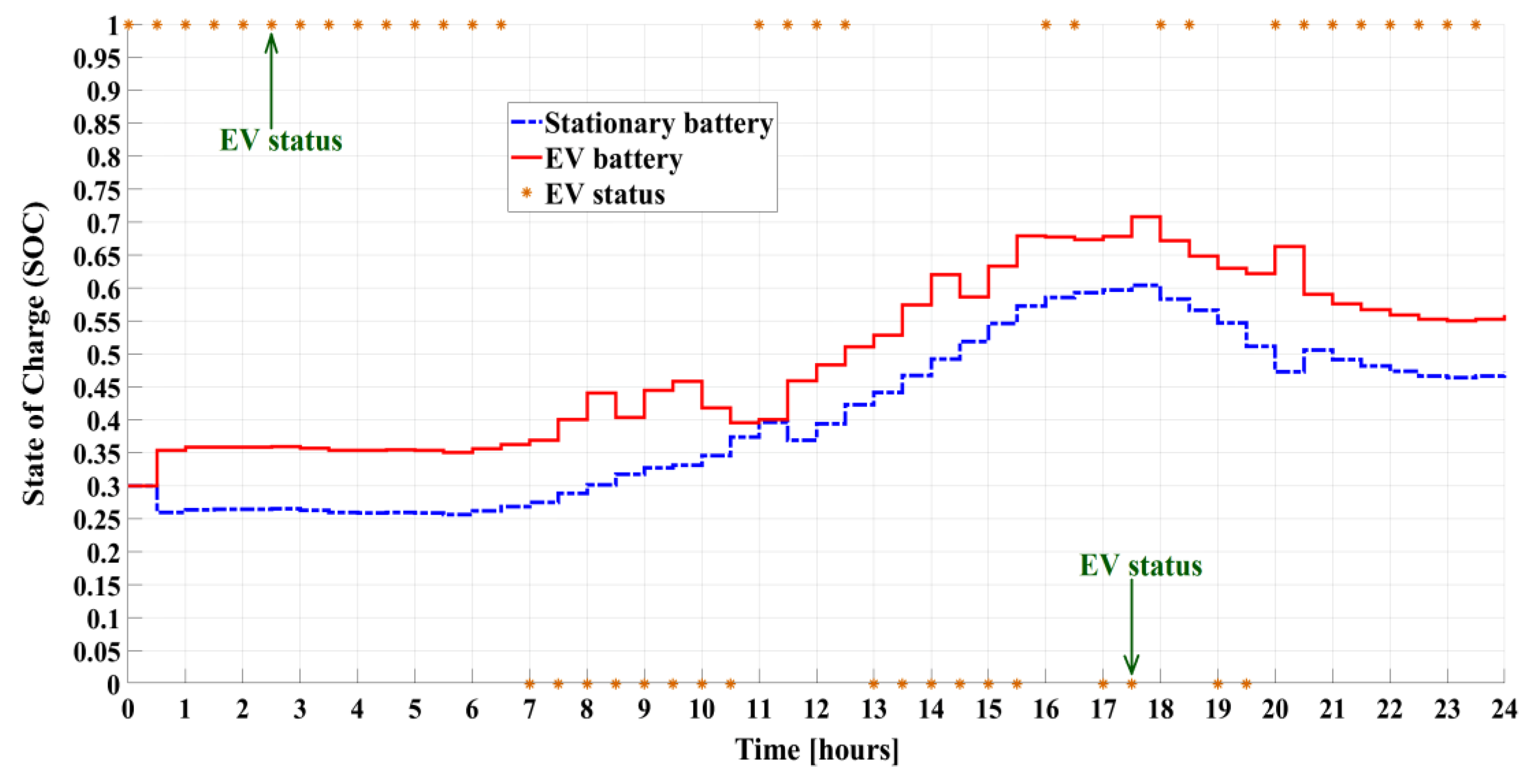
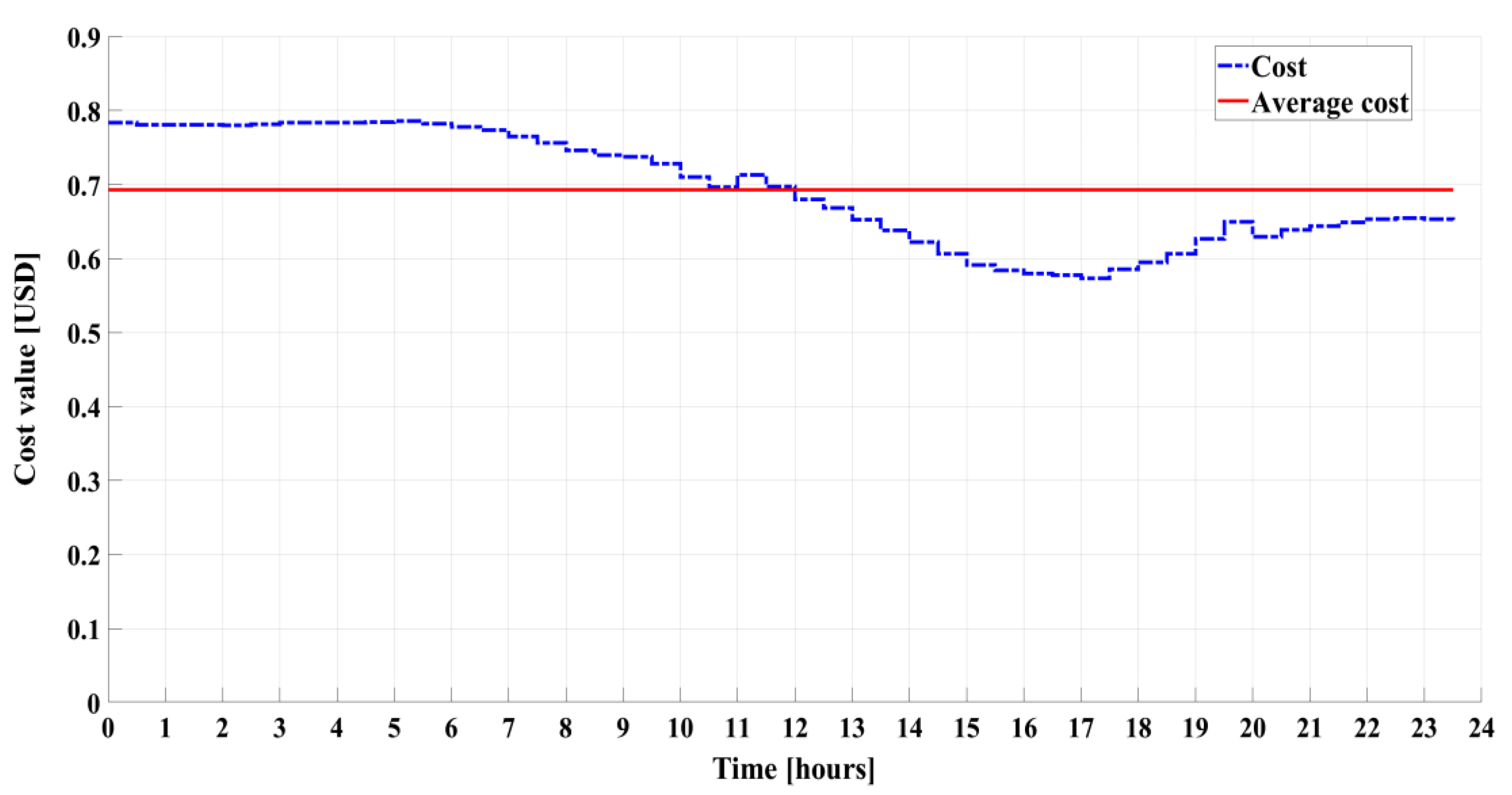

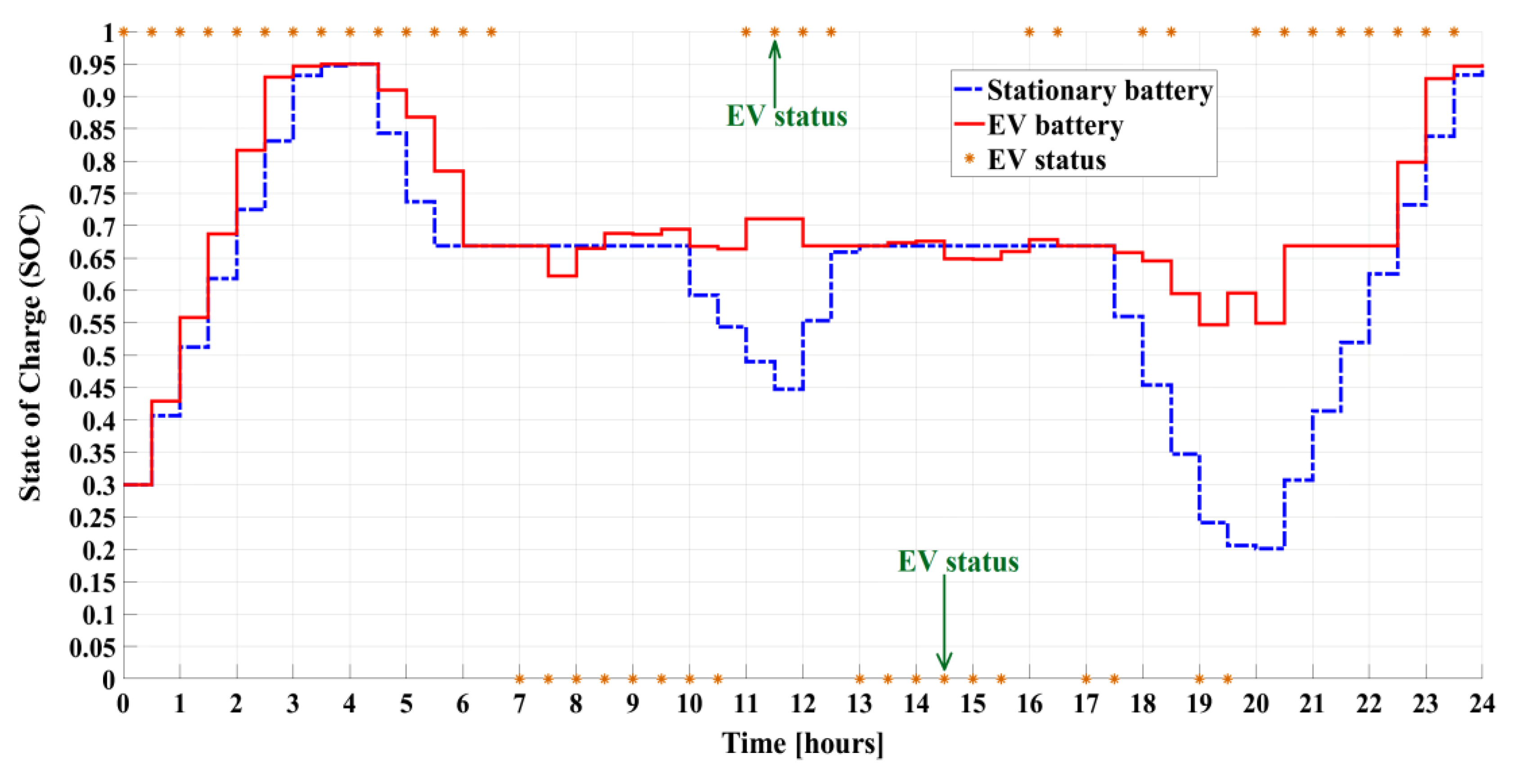

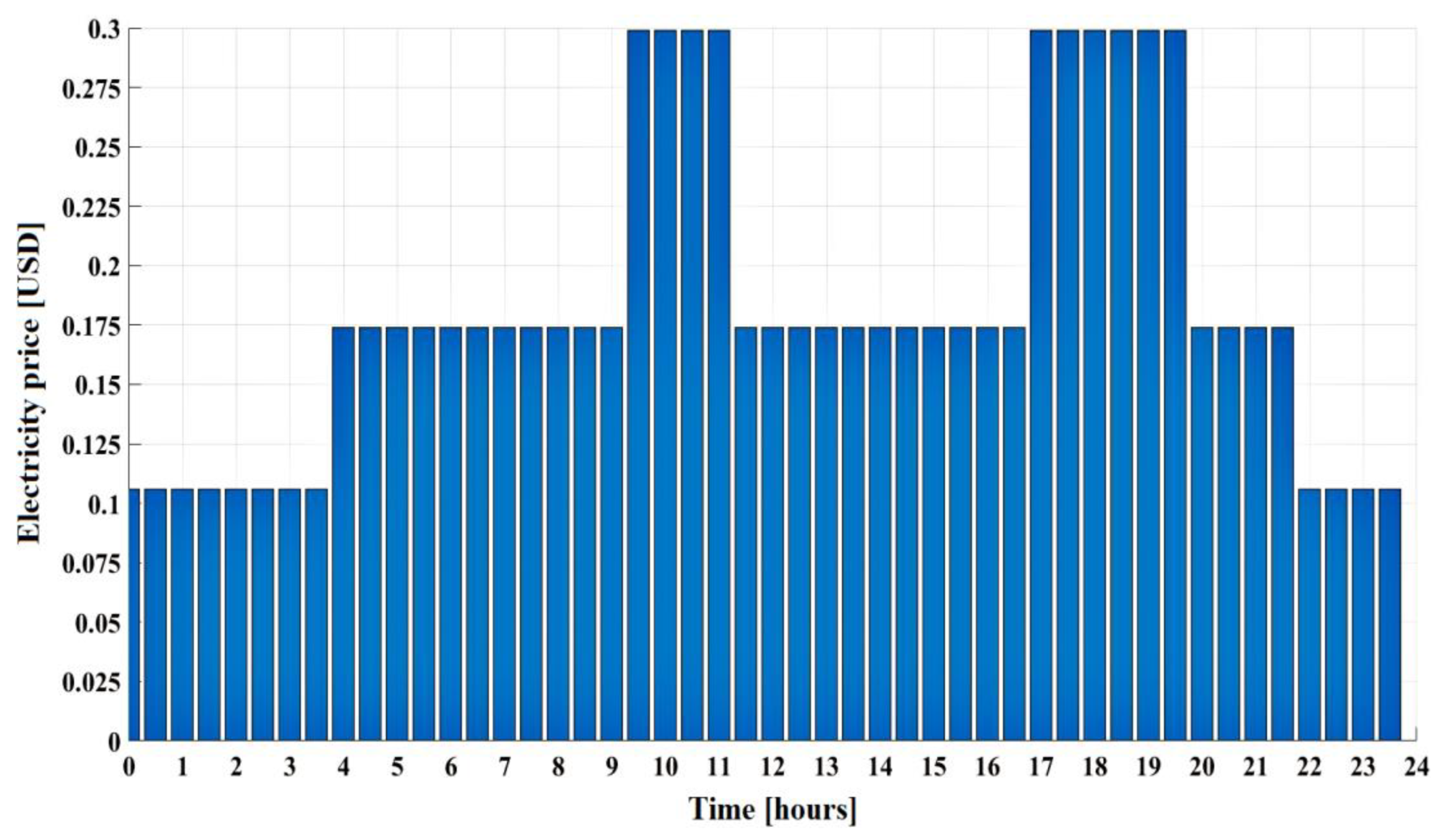
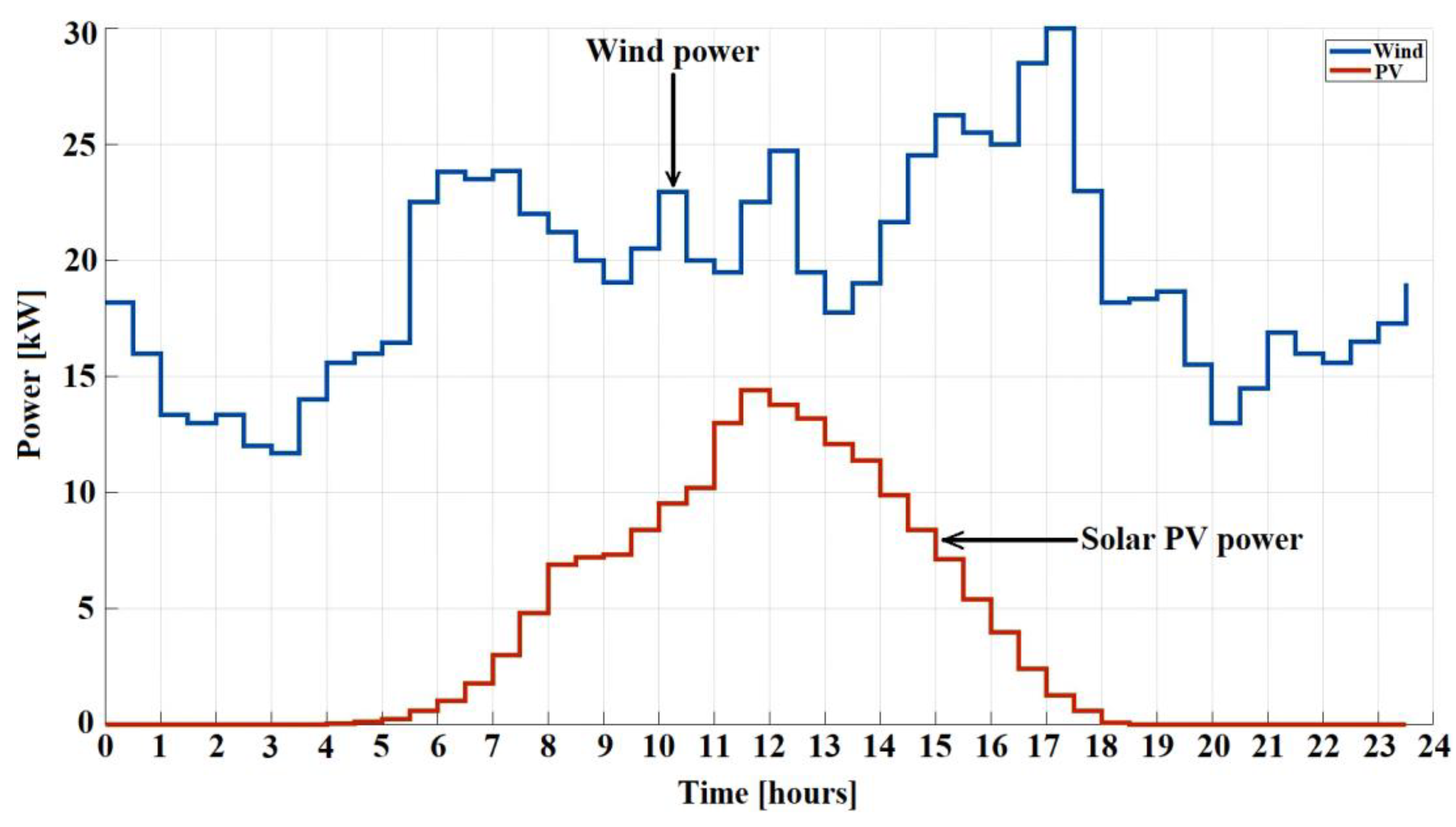
| Unit Type | Min Power [kW] | Max Power [kW] |
|---|---|---|
| Diesel engine (DE) | 5 | 30 |
| Wind turbine (WT) | 0 | 50 |
| Photovoltaic (PV) array | 0 | 30 |
| Stationary battery used as an energy storage system (ESS) | −30 | 30 |
| Buil-in battery of electric vehicle (EV) | −38 | 38 |
Disclaimer/Publisher’s Note: The statements, opinions and data contained in all publications are solely those of the individual author(s) and contributor(s) and not of MDPI and/or the editor(s). MDPI and/or the editor(s) disclaim responsibility for any injury to people or property resulting from any ideas, methods, instructions or products referred to in the content. |
© 2023 by the authors. Licensee MDPI, Basel, Switzerland. This article is an open access article distributed under the terms and conditions of the Creative Commons Attribution (CC BY) license (https://creativecommons.org/licenses/by/4.0/).
Share and Cite
Tran, H.G.; Ton-That, L.; Thao, N.G.M. Lagrange Multiplier-Based Optimization for Hybrid Energy Management System with Renewable Energy Sources and Electric Vehicles. Electronics 2023, 12, 4513. https://doi.org/10.3390/electronics12214513
Tran HG, Ton-That L, Thao NGM. Lagrange Multiplier-Based Optimization for Hybrid Energy Management System with Renewable Energy Sources and Electric Vehicles. Electronics. 2023; 12(21):4513. https://doi.org/10.3390/electronics12214513
Chicago/Turabian StyleTran, Huy Gia, Long Ton-That, and Nguyen Gia Minh Thao. 2023. "Lagrange Multiplier-Based Optimization for Hybrid Energy Management System with Renewable Energy Sources and Electric Vehicles" Electronics 12, no. 21: 4513. https://doi.org/10.3390/electronics12214513
APA StyleTran, H. G., Ton-That, L., & Thao, N. G. M. (2023). Lagrange Multiplier-Based Optimization for Hybrid Energy Management System with Renewable Energy Sources and Electric Vehicles. Electronics, 12(21), 4513. https://doi.org/10.3390/electronics12214513







